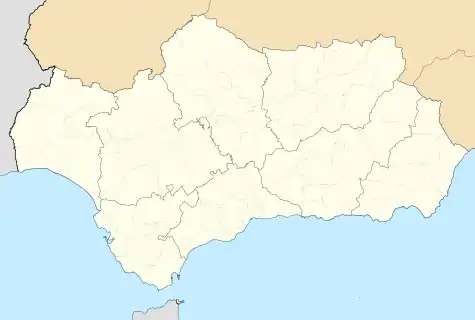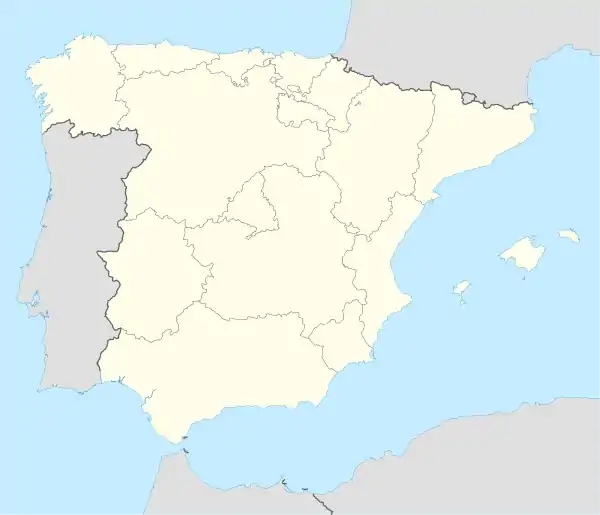Adra, Spain
Adra, the classical Abdera, is a municipality of Almería province, Spain.
Adra | |
|---|---|
 View of Adra from the water, March 2011 | |
 Flag  Seal | |
 Adra Location of
Adra  Adra Adra (Andalusia)  Adra Adra (Spain) | |
| Coordinates: 36°44′52″N 3°0′58″W | |
| Country | |
| Community | |
| Province | |
| Comarca | Poniente Almeriense |
| Municipality | Adra |
| Government | |
| • Mayor (2015– ) | Manuel Cortés Pérez (PPA) |
| Area | |
| • Total | 90.05 km2 (34.77 sq mi) |
| Elevation | 20 m (66 ft) |
| Population (2018)[1] | |
| • Total | 24,859 |
| • Density | 280/km2 (710/sq mi) |
| Demonym(s) | Abderitano |
| Time zone | UTC+1 (CET) |
| • Summer (DST) | UTC+2 (CEST) |
| Website | adra.es |
History


Abdera was founded by the Phoenicians as a trading colony. It later grew to prominence under the Roman Empire.
Adra was the last stronghold of the Moors in Spain. In January 1492 it was here that the forces of Boabdil were defeated ending the power of the Moors in Spain.[2]
Demographics
Adra had a population of 24,697 inhabitants in 2017 (according to the municipal census published by the National Institute of Statistics) - this represents an increase of 14.9% from the year 2000.
The percentage of foreign born residents was 5.2% in 2005. The majority of these residents originated from Morocco, making up 49% of the total.
The percentage of people living in the urban centre of Adra has been slowly increasing. In 2017 it represented 80% of the total municipal population.
| Year | Pop. | ±% |
|---|---|---|
| 1999 | 21,286 | — |
| 2000 | 21,505 | +1.0% |
| 2001 | 21,810 | +1.4% |
| 2002 | 22,034 | +1.0% |
| 2003 | 21,704 | −1.5% |
| 2004 | 22,257 | +2.5% |
| 2005 | 23,195 | +4.2% |
| 2006 | 23,545 | +1.5% |
| 2007 | 23,742 | +0.8% |
| 2008 | 23,880 | +0.6% |
| 2009 | 24,373 | +2.1% |
| 2010 | 24,512 | +0.6% |
| 2011 | 24,512 | +0.0% |
| 2012 | 24,626 | +0.5% |
| 2013 | 24,761 | +0.5% |
| 2014 | 24,782 | +0.1% |
| 2015 | 24,670 | −0.5% |
| 2016 | 24,713 | +0.2% |
| 2017 | 24,697 | −0.1% |
| 2018 | 24,859 | +0.7% |
| 2019 | 25,148 | +1.2% |
| Source: [3] | ||
Culture in Adra
Adra Museum: Visitors can spend their free time in the three exhibition halls of the museum, which show the cultural legacy of the Phoenician, Punic and Roman civilizations, and which educate and entertain at the same time. Important exhibitions of national prestige are periodically held here with success. The museum has a shop where archaeological reproductions can be bought. El Molino del Lugar, built around 1814 and recently renovated, is the site of the ethnographic section of the museum.
The Fair: Adra's fair is considered to be the second most important in the province of Almería and the population of Adra and countless visitors gather between September 5 and 10. The patron saint is la Virgen del Mar, who is taken out in a procession on September 8, while San Nicolás de Tolentino is celebrated on the 10th with a procession through el Barrio, the old town.
April 25 is the day of San Marcos and is important to the farmers of Adra. It is an official festival of tourist interest in Andalucía.
July 16 is the day of Our Lady of Mount Carmel, the patron saint of fishermen. A procession takes place by boat.
Bazaars take place two Saturdays a month in a carpark which is beside the Sports Center and I.E.S Abdera School.
References
- Municipal Register of Spain 2018. National Statistics Institute.
- Canby, Courtlandt. The Encyclopedia of Historic Places. (New York: Facts of File Publications, 1984) vol. 1 p. 8
- "Cifras oficiales de población resultantes de la revisión del Padrón municipal a 1 de enero". Instituto Nacional de Estadística (in Spanish). Retrieved 16 October 2019.
External links
| Wikivoyage has a travel guide for Adra. |
- (in Spanish) Official Website
- (in English) Official Website